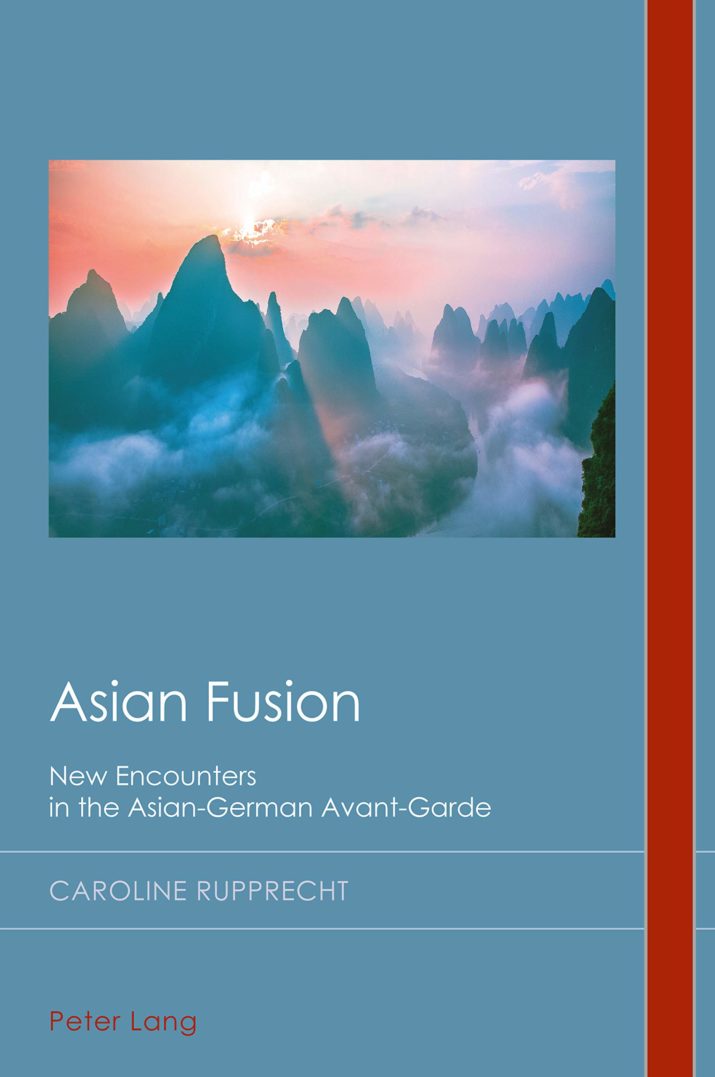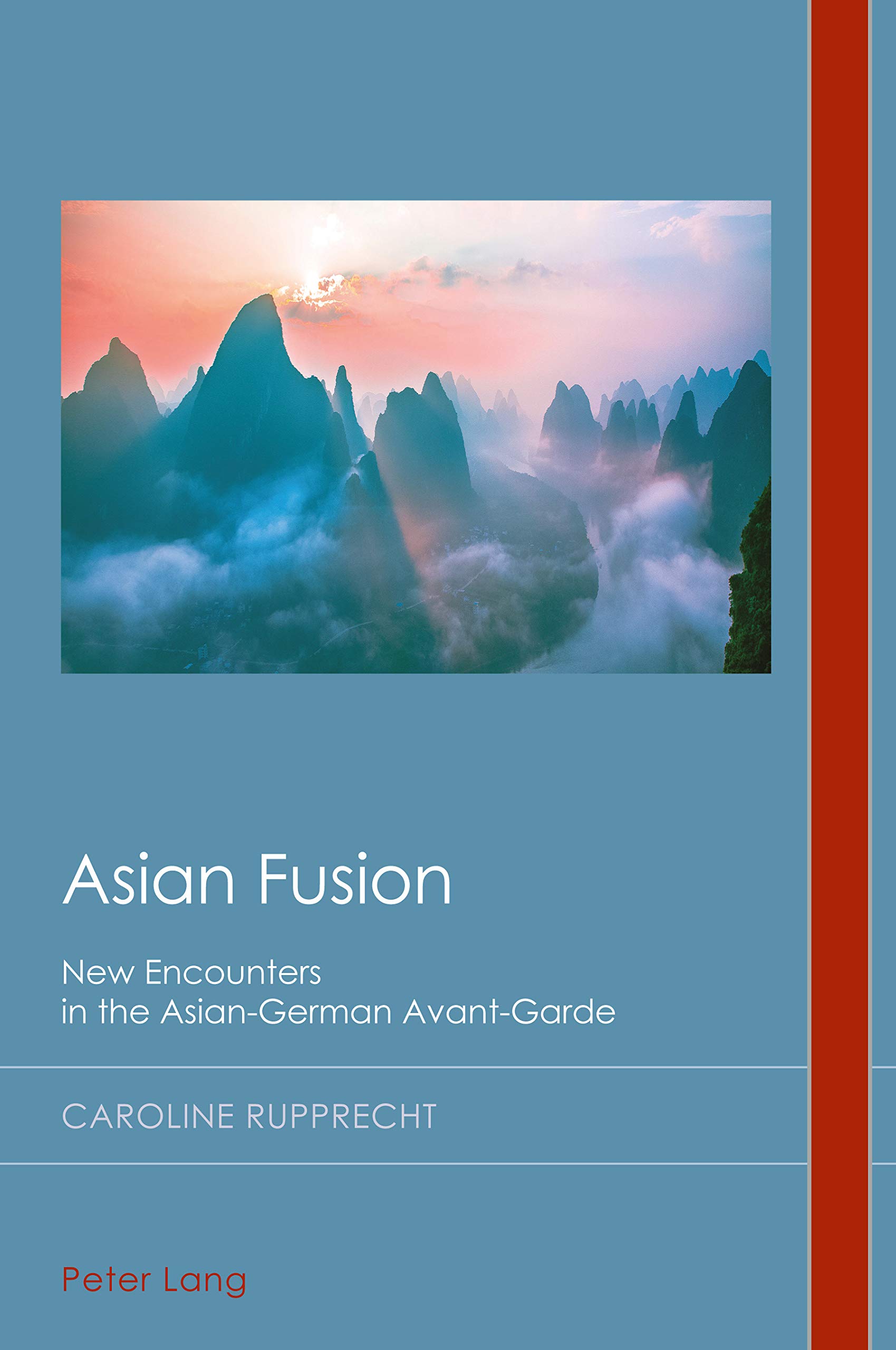

The field of Asian-German Studies is not easy to delineate. Some of its features have been charted in essay collections that considered cultural manifestations of the “contact zone:” for example, transnational studies and global German studies (e.g., Fuechtner and Rhiel 2013). A recent survey article (Zhang 2020) highlights various aspects of the field as it extends from seventeenth-century German philosophy through engagements with postcolonial theory in its various formulations, to exile studies and the study of cinema and literature. One defining link between all these research endeavors is the goal to portray the “inextricable entanglements” (109) between Asia and Germany, as well as the reciprocal nature of influences in various arenas of intellectual and artistic endeavor. Caroline Rupprecht focuses on such entanglements in her monograph Asian Fusion: New Encounters in the Asian-German Avant-Garde (Peter Lang 2020). In a question she describes as a “leitmotif” to her work she asks rhetorically: “Just how does one separate Germany’s National Socialist past from its post-World War II and contemporary present?” (16) Of course, the short answer is: One cannot. The long answer is more complicated, and her book is devoted to showing how even in an area that appears to have little obvious connection to the Nazi period and the crimes committed in the name of its deadly ideology, the link to this past is both evident and painful.
In her book, Rupprecht considers the works of three pairs of writers and artists, each composed of a white-Caucasian man of the war or immediate postwar generation and an ethnically Asian woman—though culturally of a hybrid Asian-German identity—of the following or subsequent generation. As with the “leitmotif,” Rupprecht’s metaphor for the structure of her volume is auditory or musical, i.e., she conceives of the works as “calls” and “responses,” a notion she adopts from African-American slave songs, as well as Indian and Jewish spiritual practices (6). As becomes clear through Rupprecht’s careful readings of the primary texts, there is much that was inchoate and unprocessed, and probably disavowed, in these “calls.” W.G. Sebald, Peter Weiss, and Joseph Beuys all three engaged with East Asia in their works: Sebald via musings on the historical accretions of material culture and through disturbing montages that align and juxtapose East Asian cultural practices, industrial endeavors of Nazi Germany, and the Holocaust; Weiss through his artistically unsatisfying attempt to comment upon the US war in Vietnam, linked to and filtered through his own experiences of exile, rootlessness, and tragedy; and Beuys with his pretentions to a Eurasian neo-shamanism, more designed arguably to occlude his own proximity to genocide than to heal the new Germany from the sins of the past.
Rupprecht’s readings disentangle with care and attention, and also with empathy, the various lines of transmission between these artists’ biographies, their engagement with their own respective cultural moment, and their works that seek to speak about Asia, but also about Germany and the weight of its history. Larger paradigms that Rupprecht analyzes, e.g., the construction of Jews as “Orientals” during the Nazi period and before, and hence as Asians, situate the works within the matrix of German and European culture and allow the reader to appreciate the range of discursive networks that connect German writings about Asia with discussions about national identity, anti-Semitic tropes, and the Nazi past. Rupprecht delineates the shortcomings of these “calls,” in particular their frequent inability to address Asia on its own terms rather than using it as a projection screen for German preoccupations, but she would probably agree that the impetus behind making these “calls” in the first place deserves some credit (though in Beuys’s case this credit arguably ought to be no more than minimal).
The three “responses” to these calls appear, in Rupprecht’s readings, to a significant degree more self-reflective (though Sebald too is certainly a writer very much aware of his own investments). Chronological distance may partly account for this, but inevitably the outsider’s perspective of the diasporic Asian writer or of a writer with Asian “roots” working in a German-language context, plays a role, as perhaps also does gender. For example, Yoko Tawada’s texts are haunted by the mass deaths of Hiroshima and Nagasaki and oftentimes revolve around explorations of emptiness and liminal spaces. Rupprecht’s analysis reveals their force and richness as they destabilize European notions of the Enlightenment and conceptions of the human subject itself. Rupprecht also makes clear that Tawada’s texts by one remove pose the question that preoccupies many German intellectuals with an immigrant background: what ought to be their relationship to the atrocities committed in the past by citizens of the country they themselves have now chosen as their own (64)?
Questions of identity and belonging also inform the texts by Pham Thi Hoai and Anna Kim that Rupprecht considers. Pham investigates her home country of Vietnam from the perspective of an exile (she is currently denied entry into Vietnam). In her works, the two pathways that brought Vietnamese immigrants to Germany—either as workers in the socialist brother country of East Germany, or as refugees from South Vietnam to West Germany, a group often known as “Boat People” in their many places of exile throughout Southeast Asia—also resonate and find expression. Vietnam looms large in the German cultural imagination. Resistance to the “American War” shaped an entire generation of West German students who regarded this war with another war in mind, namely that during which their parents’ generation had committed heinous crimes. The East German state, at least according to its official rhetoric, brought Vietnamese workers to the country in the spirit of anti-imperialist solidarity, only to subject the new arrivals to (subliminal) racist discrimination. Like Beuys, Anna Kim, the final author reviewed by Rupprecht, investigates the figure of the shaman and the notion of shamanic space. She does so, however, in a manner very different from Beuys’s self-aggrandizing legend of having been rescued and treated by Tartar shamans after his plane had crashed on the Eastern front in 1944. Rupprecht shows how Kim interrogates the loaded German term “Heimat” (which one can approximately translate as “homeland,” though without quite conveying the term’s affective charge), a concept that was and has remained implicated in reactionary politics and policies. Kim considers her (South-)Korean heritage and, via recourse to German history, works through the relationship between a victimized Korea and an aggressive imperial Japan. All these texts, both the “calls” and the “responses,” emerge freshly illumined in Rupprecht’s analyses. Through her remarkable framing, they speak to each other across the generations.
Rupprecht’s volume could have further explored the notion of the avant-garde, which the subtitle references, or more precisely the different kinds of avant-garde that manifest in the works considered. Tawada, for instance, in her multi-lingual poetry (poetry, in fact, that combines different writing systems), can no doubt be read as avant-garde in the classic early twentieth-century sense of radical experimentation. The same holds true for Beuys, in his own idiosyncratic way; for Peter Weiss the label also fits, though his is a different kind of avant-garde, in the tradition of Brecht and socially engaged theater. For Sebald, the issue is not clear-cut. His treatment of his subject material is certainly original, and his inclusion of (manipulated) visuals in his texts is also formally interesting, but his prose rarely ventures into the territory of radical experimentation. Pham’s writings do hark back to Brechtian and Kafkaesque techniques, though these in the late twentieth/early twenty-first century are perhaps less artistically daring and rather a strategy to mobilize a modernist tradition of inquiry and critique, and the same might also be said for Anna Kim’s prose.
The avant-garde Rupprecht conceives of in her volume is, one might argue, only partly characterized by formal artistic innovation. Rather, it is the novel, self-reflective, multi-perspectival treatment of subject matter that defines her corpus of texts—it is an avant-garde more of substance than of style. Rupprecht’s voice, as she investigates this avant-garde, is both engaged and engaging. She does not shy away from pointing toward the bearings her work has upon the contemporary scene of German politics and culture. Post-unification Germany has struggled to come to grips with its own cultural and social heterogeneity, to define a coherent national narrative, and to develop a productive and inclusive vision for its own (future) identity. Rupprecht’s analyses have obvious implications for the study of migrant communities in Germany and of their relationship to mainstream German culture. Beyond this aspect of her work lies—arguably as the most trenchant point of her study—Rupprecht’s placement of these debates within the long shadow the Nazi period casts over contemporary Germany. The country is culturally, politically, and socially engaged in a process of negotiation as regards the relationship to this past. Asian-German Studies has thus far perhaps not fully taken account of the complexity of this negotiation process and of how it is refracted within contemporary literature and artistic productions that work through German views of Asian countries, their histories and cultures. There certainly have been efforts to read these discursive networks (see, e.g., Qinna Shen’s article on the 2009 German film John Rabe, which portrays the ambiguous figure of the titular character, a Nazi party member, and dramatizes his commendable behavior during the wave of atrocities committed by the Japanese military in Nanjing in 1937–38). However, one might say that the field of Asian-German Studies itself, as far as its post-WW II investigations is concerned, has for some time been the recipient of a “call” from scholars and artists that address the Nazi period and the Holocaust. Rupprecht’s volume has now provided a comprehensive response—hers is a timely and important book, as well as an excellent read.
Martin Rosenstock is Assistant Professor of German Studies at Gulf University for Science and Technology in Kuwait. He is the co-editor, with Qinna Shen, of Beyond Alterity: German Encounters with Modern East Asia (Berghahn, 2014). He has published on German colonial history as well as on the depiction of the colonial period in contemporary German literature.
Asian Fusion: New Encounters in the Asian-German Avant-Garde
By Caroline Rupprecht
Publisher: Peter Lang
Paperback / 264 pages / 2020
ISBN: 978-1-78707-357-9
References:
Fuechtner, Veronika, and Mary Rhiel, eds. 2013. Imagining Germany Imagining Asia: Essays in Asian-German Studies. Rochester, NY: Camden House.
Shen, Qinna. 2011. “Revisiting the Wound of a Nation: The ‘Good Nazi’ John Rabe and the Nanking Massacre.” Seminar: A Journal of Germanic Studies 47 (5): 661-80.
Zhang, Chunjie, ed. 2020. “What is Asian German Studies?” The German Quarterly 93 (1): 106-141.
Published on December 8, 2020.




